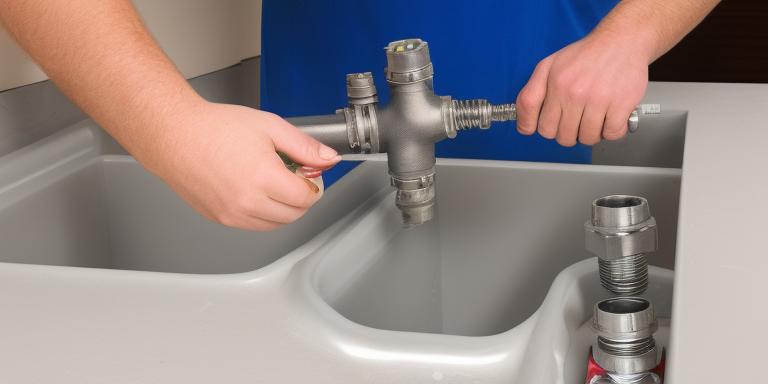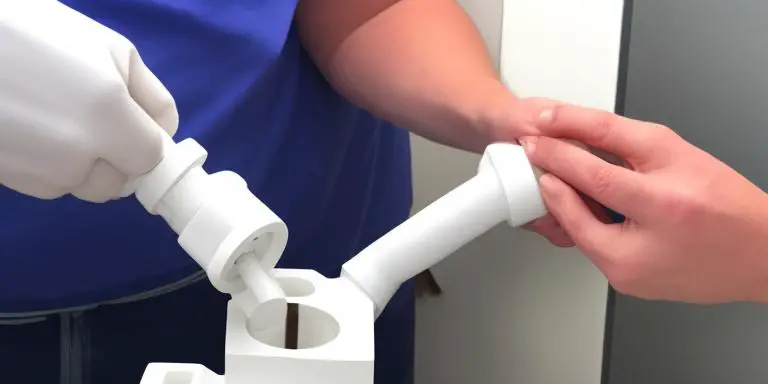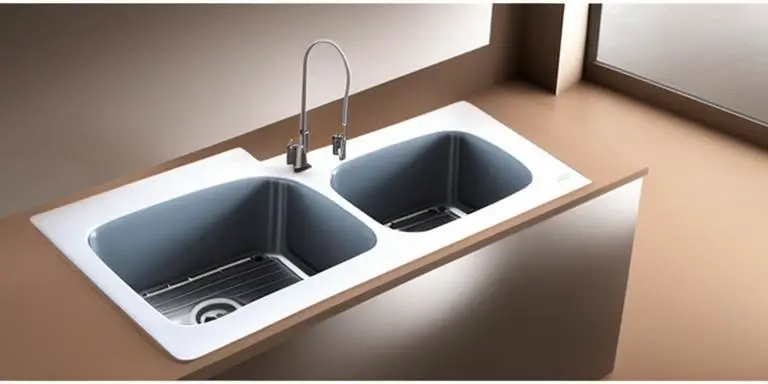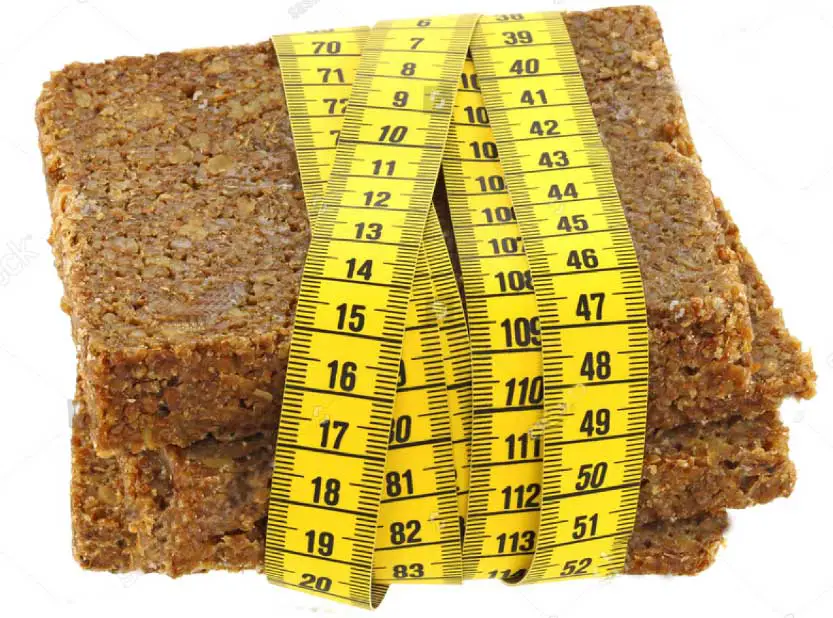Many people are constructing modern kitchens with double kitchen sinks. This is because of the many benefits the user is going to enjoy. For instance, you can wash your dishes in one sink and rinse them in the other. Besides, you can use one to soak your stained pans. Unfortunately, not everyone knows how to plumb a double kitchen sink. Yes, you can have a professional plumber do this for you, but you can also do it. If you wish to plumb by yourself, follow the steps below to the end for successful outcomes. Happy Plumbing!
10 Easy Steps on How to Plumb a Double Kitchen Sink
Plumbing a double kitchen sink is not tough. But it is only possible when you have the right tools, parts and knowledge to do that. Below are some of the essential steps you must follow to successfully plumb your double kitchen.
What you need:
- Double sink
- Marker
- Channel locks
- Caulking guns
- PVC pipe cutter
- Hacksaw
- Screwdriver
- Sanitary tee
- Plumber’s putty or silicone caulk
- Double sink
- Washers
- Compression nuts
- PVC pipes
- Sink drain and strainer basket
- Faucet
Instructions
When you have everything, you are ready to begin the plumbing process. But make sure you also have a person to help when necessary. Besides, you need something that is cushioned to help you kneel on it when you are ducked under the sink. Without further ado, let us dive into the crucial steps you should follow to successfully plumb a double kitchen sink.
1. Prep and measure the sink and counter

You should first measure your sink and counter and ensure they are a good fit. If you want to replace a regular sink with a double one, you will need to add another sink to the counter. Be aware that the sink basin should sink through the hole, not the sink lip. It is the major role of the lips to brace the sink against the countertop and support your sink weight. This space is necessary for drop-in sinks and under-mount sinks.
Also, the water running to your sink must be shut off. One way you can do that is by using cold and hot knobs to stop water at the site. Else, you can turn your main water valve and drain the pipes. Only move to the next step when you have prepped, measured and stopped the water.
2. Attach sink strainers
Take your time to install sink strainers in the two basins. It is possible to do this when the sink is detached from the counter. Alternatively, you can do this after lowering the sink. No matter the method you choose, both will accomplish a similar goal. You can proceed to the next step when the strainer baskets and the drain are popped in and set with the plumber’s putty or silicone caulk.
3. Double sink installation
The double sinks come in two different styles. How to install them is dependent on which one you choose. One of the common styles is the undermount sink which does not have a lip, and the drop-in sink, which features a broader lip. Drop-in sinks have a wider lip to let them sit on the counter as the basin dips into the pre-cut hole. With no lips, the undermount sinks are clamped, glued, and screwed in place below the counter. If installing an undermount sink, you need a friend to hold it as you secure it.
4. Make sure the drain outlet pipe is at the right height
At this point, check to see if the drain outlet pipe at the wall’s back is at the right height. It should be high enough for your P-trap to set perfectly and perform its work while low sufficient to permit space for sanitary tees and tailpieces. Using a tape measure is the perfect way to ensure you have the correct height. You can then compare the measurements with your pipe measurements. Call a plumber to reconnect the outlet pipe height to the mainline behind the wall if you find it is off.
5. Install two drain tailpieces

If you are sure your pipe zone has the right measurement and is ready for the next step, it is now the right time to attach the two drain tailpieces. The pipes connect the drain to the sanitary tees. At times, the pipes’ lengths may differ. But this is dependent on your outlet pipe configuration. Use a PVC pipe cutter or a hacksaw to make them the same height. Use compression nuts at the drain baskets’ connection points. While doing this, avoid to over tighten the nuts. Doing so can make the PVC crack.
6. Add a sanitary tee

Your preferred installation and space limitations determine the pipe configuration. The two tailpieces can connect with two PVC pieces and 90-degree sanitary fittings, meeting in the middle of the sanitary tee. The design resembles a Y letter as two lines meet at the center and become one.
Alternatively, you can connect a sanitary tee directly to one of the drain’s tailpieces. Here, one side bend connects to the sanitary tee while the other runs straight down. The bend on the second side is formed by a 90-degree sanitary fitting attached to the tailpiece. On the other hand, a PVC pipe piece runs from this fitting to the sanitary tee. Compression nuts are used in all the configuration meeting points.
It is advisable first to form these connections void of attaching anything. This is meant to help you get an idea of what the final piping will look like. Again, if you find issues in the process, you can fix them before twisting them into place.
7. Install a drain trap
This trap collects a small amount of water and prevents terrible odors from rising from the sink. To install the drain trap, you need a J-shaped and U-shaped trap. The J-trap is responsible for ferrying water to the drain outlet pipe, while the U-trap connects to the sanitary tee. While installing them, start by clicking the U-trap on the sanitary tee using a compression nut. Then use the hooked part of the J-trap to connect it to the U-trap. When the two are well-connected, line up to the J-trap’s straight end to the drain outlet and connect.
8. Mount the faucet
This is done by threading the mounting bracket and cold and hot water lines through the countertop. Next, use a series of channel locks to tighten the nuts at the faucet’s lower end. Doing this help make sure it is safe on your kitchen counter.
9. Connect the water lines
Link the cold and hot water lines to their respective pipes. Use channel locks to tighten them as required.
10. Inspect for leaks
This is done by switching on the cold and hot isolation valves. Take your time to open the faucet to release any trapped air and allow water to run into the sink. If there are no leaks, you are good to go. You can be sure your double kitchen sink plumbing is successful.
Benefits of having a double kitchen sink
Nowadays, double kitchen sinks have become popular. A lot of people prefer to have them in their kitchens. This brought about an interest in knowing why this is the case. Below are some of the reasons why this is the case.
One sink helps in the garbage disposal
A garbage disposal is one of the safest ways to remove food waste from your kitchen. This is because they factually churn up the food bits until they are small enough to pass through the plumbing void of clogging. In this case, a garbage disposal is installed under the sink to allow you to scrape food into it. With this in order, you can use the other sink, free to use according to your preference.
It helps to keep clean dishes aside
If your kitchen is not big, you might struggle with space for your dishes. The help of two sinks comes in because you can use one of them to put your clean dishes. Hence, you will not need an extra drying rack.
Allows you to separate cleaning and soaking
If your pan has tough stains, it is worth allowing it to soak. Nonetheless, if your sink is always occupied, you may face challenges. Luckily, a double kitchen sink is of great help. You can use one for your dishes and the other for soaking your things.
Helps in multitasking
When you have two sinks in your kitchen, you will enjoy efficiency. You can use one while another person is using the other one. At long last, you realize work become easier at home.
What to do if you plumb your double kitchen sink incorrectly
Even though this is the last thing you want, it sometimes happens. So what do you do if it takes place? The following are the things you should do to fix it.
Remove and install the sink again
If you realize your kitchen sink is not draining correctly or water is not entirely going down in either sink, what follows is to remove the sink and install it again. Doing this allows better access as you make the necessary repairs. Start removing the sink by shutting off the water supply valve under the two faucets that feed into that specific drain line.
In case you use a quartz or granite countertop, attach the clips that come with the sink using epoxy. Otherwise, use silicone caulk to attach the sink clips if you use a laminate countertop. Lastly, reattach every drain tailpiece and pop-up assembly. Tighten them into place using an adjustable wrench.
Snake the drain pipe
This is the alternative you need to go for if the first one does not work. You can insert a long metal wire into the clogged drain. Turn and twist the wire until you dislodge the clog. When you are done, flush the drain using water. If the clog does not dislodge even after trying several times, you should call a certified plumber to unclog the drains for you.
Cut into the pipes and use a drain auger to clear out clogs
This is the last option you must go for if the above two do not work. Doing this will allow you to access the inside of your plumbing system. When the snake-like reaches where the two drains connect, use one of your hands to rate its handle clockwise while the other hand holds onto the end of the wire. The benefit of doing this is that it helps break up any clogs and eliminate them from the drain pipe.
Note: Before you start this process, ensure the water supply valve is off.
Complete install Double Bowl Kitchen Sink
Frequently Asked Questions (FAQs)
Can you make a single sink a double sink?
You can replace a single sink with a double sink. You can use a double sink to store foods or anything else you want to be kept away from the house. For instance, if your home features a big kitchen and a small dining room, two separate sinks can help separate drinks and foods. The sinks can be used to hold drinks and foods separately.
Can two sinks share the same water line?
Mostly, you can adapt the drain and supply pipes to accommodate two sinks. You can use special valves, hoses, extension pipes, and tee fittings. Depending on your local plumbing codes, you can vent each sink separately.
Does a double kitchen sink need a vent?
Each sink needs a sink vent. A plumbing fixture like a sink can’t work correctly.
Rita C. Donnell (Jennifer) has spent the last 26 years studying and practicing nutrition science. She has used a larger part of this time in improving people’s livelihoods. She has done so by coming up with unquestionable ideas on how to tackle food problems in her community. Readmore



